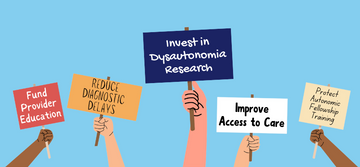
This post was written in collaboration with Rowe’s Research Runners. The mission of RRR is to fundraise, increase awareness, and facilitate connections for people with myalgic encephalomyelitis/chronic fatigue syndrome (ME/CFS), dysautonomia, and related illnesses (now including Long COVID).
After Kate Sanchez’s freshman year playing division one field hockey at James Madison University, she came down with mononucleosis. Her symptoms came and went over the course of about a year until she collapsed during training and could no longer find the energy to get out of bed. After seeing many specialists, Dr. Peter Rowe at Johns Hopkins Hospital diagnosed her with ME/CFS and orthostatic intolerance (OI).
Nineteen years later, Kate has gone on to graduate from college, earn her master’s degree, become a college professor, get married, and have two children. However, she also struggles with symptoms like widespread pain, migraines, lightheadedness, floaters in her vision, a heartrate of up to 160 BPM, loss of vision, anxiety, and bouts of depression and apathy.
“Days are full of balancing the wants of my body to run, to play with my kids and sometimes to stand up, with its limitations and my mental state,” Kate said. Kate is not alone — an estimated 5 to 9 million Americans and 17 to 24 million people worldwide have ME/CFS, up to 97% of whom also have OI.
What is ME/CFS?
Myalgic encephalomyelitis/chronic fatigue syndrome (ME/CFS) is a complex chronic physical health condition with the main feature being post-exertional malaise (PEM), which refers to symptoms worsening for more than 24 hours after minimal physical or mental exertion.
Symptoms can include:
- Lightheadedness
- Neurocognitive impairments like difficulty processing information, and short-term memory loss (often termed “brain fog”)
- Pain in joints and muscles
- Headaches
- Sleep disturbance like insomnia
- Neurosensory, perceptual disturbances like sensitivity to light or sound
- Flu-like symptoms
- Gastrointestinal symptoms like nausea or abdominal pain
- Sensitivities to food, medications, odors, or chemicals
- Autonomic nervous system disorders, such as hypotension, postural tachycardia syndrome, or symptoms with upright postures (orthostatic intolerance)
- Problems with temperature regulation (chills, heat intolerance)
- Excessive sweating
You may have heard of it referred to as Chronic Fatigue Syndrome. However, this name does not reflect how severe the symptoms can be or the severity of impaired functioning. The Centers for Disease Control and Prevention (CDC) and the National Institutes of Health now use the term ME/CFS, for myalgic encephalomyelitis/chronic fatigue syndrome to reflect how complex and systemic the disease truly is.
Who can get ME/CFS?
Anyone can get ME/CFS, but research suggests it occurs in women 2 to 4x more often than men and onset most commonly occurs in 30- to 50-year-olds.
What causes ME/CFS?
Research into the cause of ME/CFS is ongoing, but researchers have found connections to genetics, the central nervous system, and immune and metabolic factors. It is often triggered by a virus like COVID-19 or mononucleosis. An estimated 1 out of 10 people who develop certain infections, like Epstein-Barr virus and mononucleosis, end up developing ME/CFS.
What is orthostatic intolerance?
Orthostatic intolerance (OI) is when symptoms — most commonly lightheadedness, fatigue, difficulty thinking, and headache — occur when people are in positions of quiet upright posture (mostly standing still, but symptoms can be present with sitting as well).
Other symptoms of orthostatic intolerance may include blurry vision, heart palpitations, nausea, or fainting upon sitting up or standing.
There are several types of orthostatic intolerance related to autonomic nervous system disorders, including:
- Postural Orthostatic Tachycardia Syndrome (POTS), where the heart rate increases by at least 30 BPM in adults (40 BPM in adolescents) upon standing.
- Orthostatic Hypotension (OH), where the systolic blood pressure decreases by at least 20 mm Hg or the diastolic blood pressure decreases by at least 10 mm Hg within the first three minutes of standing or head-up tilt table testing.
- Neurally Mediated Hypotension (NMH), which is often referred to as neurocardiogenic syncope , vasovagal syncope, or reflex syncope. Syncope means fainting. In these individuals, blood pressure can drop abruptly. Not all people with neurally mediated hypotension have fainted in day-to-day life.
- Low orthostatic tolerance: These individuals have abnormal reductions in brain blood flow along with orthostatic symptoms, but do not have abnormal changes in blood pressure or heart rate.
The connection between orthostatic intolerance and ME/CFS
Up to 97% of patients with ME/CFS are estimated to also have orthostatic intolerance.
In 1995, Dr. Peter Rowe and colleagues were the first to discover a connection between ME/CFS and orthostatic intolerance. In a study of 23 patients with ME/CFS and 14 healthy controls, 22 of the patients with ME/CFS had abnormal responses during a tilt-table test, in comparison to just four of the controls. When given medications for orthostatic intolerance, many of the patients with ME/CFS reported improvement, some describing complete or nearly complete resolution of their symptoms.
"Many of us with ME/CFS, like myself, don't faint, but we still rely on counter maneuvers like crossing our legs,” said Emily Steffensmeier, founder of Rowe’s Research Runners. “When I talk to my friends with ME/CFS we often share stories of crumpling to the ground in unusual places because we can't tolerate standing--and we laugh about the many places we've found ourselves sitting or lying down.”
How is orthostatic intolerance diagnosed?
If you believe you may have orthostatic intolerance, you should speak with your healthcare provider, especially if you have already been diagnosed with ME/CFS. It may be helpful to perform a passive standing test (sometimes called a “poor man’s tilt table test”), where you monitor your blood pressure and heart rate while lying down for five minutes, then during 10 minutes of standing, and another 2-5 minutes after lying down again. This test can be done in a provider's office or at home but needs to be supervised by someone because there is a risk of fainting during the test.
Some practitioners are comfortable performing the standing test in the office, but others might refer you to a neurologist or cardiologist, who will perform a tilt-table test. They may also order other tests to rule out other causes of abnormal changes in heart rate and blood pressure.
Treating orthostatic intolerance in patients with ME/CFS
"Orthostatic intolerance is the most treatable symptom in ME/CFS, which is what makes it so important to, one, raise awareness of the connection, and two, treat it,” Emily said. Unfortunately, there is currently no cure for orthostatic intolerance. However, Emily pointed out, there are some treatments and lifestyle changes that may help, including:
- Treating any underlying conditions that may be contributing to OI.
- Taking medications like beta blockers, midodrine, fludrocortisone, and others.
- Wearing compression garments.
- Dietary changes like increasing fluid and sodium intake and eating small, low-carb meals. Specifically formulated to support people living with chronic illness, Vitassium provides sodium and potassium to help manage symptoms of OI and other chronic conditions.
- Making adaptations to your routine, like sitting while doing activities or using a mobility aid when standing for extended periods.
- Getting up slowly and using postural counter-maneuver when standing (for example, crossing one leg over the other, shifting your weight, and using the leg muscles as a pump to get blood back up to the heart).
You should speak with your provider about the best treatment options for you.
“Overall, my world has become small and so different than it was, than I had planned for my life. Yet, this experience has also been positively life-changing! I discovered the profound strength of my spirit. Despite all the mountains and valleys, I've never given up hope; I've never lost the feeling of a fighter,” Kate said about her journey.







